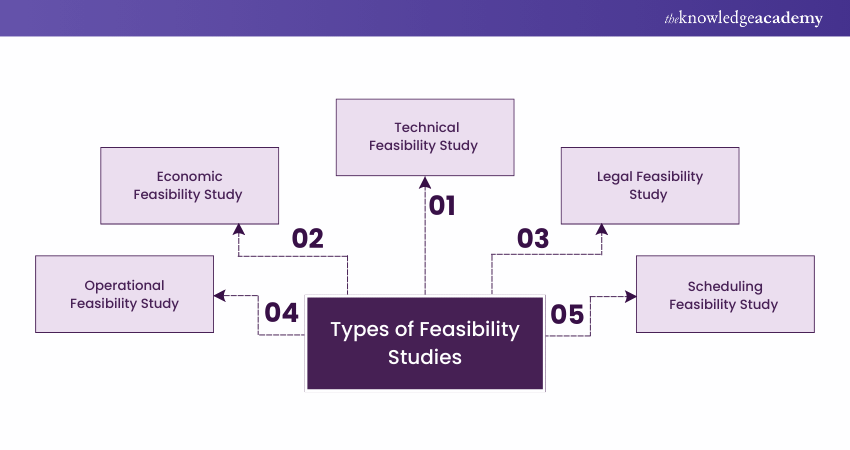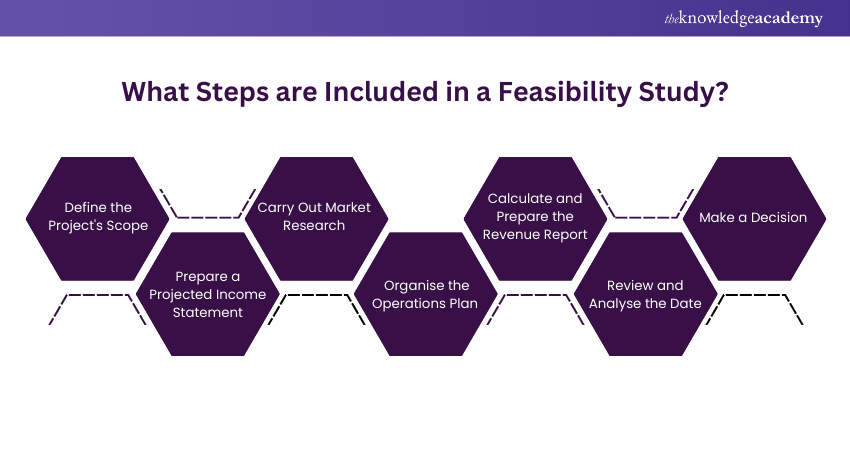We may not have the course you’re looking for. If you enquire or give us a call on 01344203999 and speak to our training experts, we may still be able to help with your training requirements.
We ensure quality, budget-alignment, and timely delivery by our expert instructors.

Consider this scenario: you have a brilliant idea for a dog-friendly café that will include cosy corners, pup treats, and coffee for humans. But before you dive in, how do you know it’s worth the investment? That’s where the big question comes in: What is a Feasibility Study? It’s not just a box to tick; it’s a tool that helps you test the waters before taking the plunge.
But will your idea work in your chosen location? Is there enough demand? Can you make a profit? These are the things a Feasibility Study uncovers before you spend your first pound. In this blog, we’ll break down What is a Feasibility Study, explore its key types and benefits, and share real-life examples that show how it makes or breaks bold ideas.
Table of Contents
1) Feasibility Study: An Overview
2) Benefits of Conducting a Feasibility Study
3) Types of Feasibility Study
4) What is Included in a Feasibility Study Report?
5) Seven Steps to do a Feasibility Study
6) Examples of a Feasibility Study
7) How Reliable are Feasibility Studies?
8) What Percentage is a Feasibility Study?
9) Conclusion
Feasibility Study: An Overview
A Feasibility Study examines all key aspects of a business idea, including costs, legal requirements, and technical needs. It helps companies decide if a project is achievable and worth the investment. It also highlights potential problems that can be solved before starting. Feasibility depends on the industry and business goals.
Some companies judge success by profits, while others prioritise customer retention. These studies apply to various decisions, from big policy shifts to small team tasks.
Benefits of Conducting a Feasibility Study
Conducting a feasibility study before launching a new project offers several key benefits:
a) Confirms market opportunities and target market before committing significant resources.
b) Identifies potential issues and risks early in the process.
c) Provides detailed data for better decision-making regarding the project's viability.
d) Documents expected costs and benefits, including financial analysis.
e) Demonstrates due diligence, gaining stakeholder buy-in.
Feasibility studies are crucial for projects that require substantial investments or have a major impact on your market presence.
As a Project Manager, you might not directly handle the Feasibility Study, but understanding its elements can help you support the team conducting it and ensure the best outcomes for your project.
Types of Feasibility Study
There are many factors to consider when determining project feasibility. You might conduct various types of feasibility study to assess your project from different angles.

Technical Feasibility Study
A technical Feasibility Study aims to verify whether the organisation is eligible to use its technical in-house resources and expertise to perform successfully. This assessment involves scrutinising various aspects, including the following:
a) Production Capacity: Does the company have the resource base to produce that number of products and services for the customers?
b) Facility Needs: Will today’s facilities fulfil the standards required, or will new facilities be constructed?
c) Raw materials and Supply Chain: Are there enough purchases, and have the organisation maintained a supply chain?
d) Regulatory Compliance: Does the Project Execution follow the relevant guidelines and do professionals have the relevant certifications to meet the requirements and industry standards?
Economic Feasibility Study
It is a financial Feasibility Study that primarily examines the project's financial viability. The economic Feasibility Study typically involves several steps:
a) Determining Capital Requirements: Calculate funding collection, overhead, and other capital.
b) Cost Breakdown: Determining and listing all the project costs including the purchase of materials, hardware, labour, and overheard costs are too.
c) Funding Sources: Trying out a variety of possible solutions like banks, stakes, or grants.
d) Revenue Projection: By using prediction tools such as a cost-benefit analysis or business forecasting to get the level of income, return on investment and profit margin.
e) Financial Analysis: Projecting the performance of the Project based on means that are related to a financial analysis and are characterised by the utilisation of such things as cash flow statements, balance sheets and financial projections.
Learn the tools and methods to manage projects by signing up for our Running Small Projects Training- Join now!
Legal Feasibility Study
Legal Feasibility is a type of analysis that seeks to confirm that a pProject follows all the relevant laws and regulations. Key considerations include:
a) Regulatory Compliance: Briefing the whole project team about all required laws and regulations that the project has to comply with.
b) Business Structure: Assessing the legal systems [e.g., Limited Liability Companies (LLCs) vs Corporations] that would best protect liability, governance, and minimising taxation, if any.
Operational Feasibility Study
An Operational Feasibility Study explores how well a proposed system or product will function within the day-to-day operations of a business. It also considers how practical the solution will be for regular use and ongoing support.
a) Checks Everyday Usability: It looks at how easily the system can be used by the intended users and whether it integrates smoothly into existing processes.
b) Assesses Long-term Maintenance: This involves evaluating how manageable the system will be to update, fix, and support over time.
c) Includes Development Team Input: Feedback from the Application Development team is key in understanding potential technical challenges and improvements.
d) Measures Operational Alignment: It ensures the proposed solution not only works but fits well with the business's goals, workflows, and resources.
Scheduling Feasibility Study
A Scheduling Feasibility Study focuses on whether the proposed project timeline is realistic and achievable. It plays a vital role in ensuring deadlines can be met without compromising quality or exceeding budget.
a) Reviews Project Timelines: It examines whether the proposed deadlines are reasonable based on the project scope and available resources.
b) Estimates Task Durations: Each phase of the project is assessed to predict how long specific activities will take.
c) Checks Resource Scheduling: It considers whether the necessary people, tools, and materials will be available at the right time.
d) Identifies Risk of Delays: By spotting possible bottlenecks early, it helps avoid missed deadlines and negative knock-on effects for the business.
Acquire the necessary skills to effectively deliver projects by signing up for our Project Management Office Fundamentals Training now!
What is Included in a Feasibility Study Report?
The results of your project feasibility study are gathered in a feasibility report, which typically includes these elements:
a) Executive summary
b) Description of the product/service
c) Technology considerations
d) Product/service marketplace analysis
e) Marketing strategy
f) Organisation and staffing
g) Project schedule
h) Financial projections
i) Findings and recommendations
Seven Steps to do a Feasibility Study
As Feasibility Study is a crucial step in determining the potential of a project, it involves a substantial period of time and resources. Let’s take you through some of the steps involved in the following points:

1) Do a Preliminary Analysis and Define the Scope of the Study
a) Before starting a Feasibility Study, conduct a quick check to ensure it's worth the time and resources.
b) Feasibility Studies can be resource-intensive, so it's crucial to determine early if the investment is justified.
c) Assess whether the study offers valuable insights and if key stakeholders need to be involved.
d) Here are some key questions to answer:
i) What are the potential benefits of the project?
ii) What challenges or risks might arise?
iii) What resources are required for success?
2) Prepare a Projected Income Statement
a) Obtain an income statement projection to estimate future earnings and expenses.
b) The statement provides a yearly breakdown of revenue and costs.
c) It helps determine profitability and financial feasibility.
d) Small businesses need marketing strategies to support growth.
e) These insights are big drivers of informed decisions among business owners.
Learn risk identification and mitigation plans with our comprehensive Project Risk Management Course - Sign up now!
3) Carry Out Market Research
a) Market research is essential for an effective Feasibility Study.
b) It helps determine the viability of the project.
c) It helps identify target customers, competitors, and market size.
d) It provides insights into potential market share.
e) It can be conducted through surveys, expert consultations, and Social Media analysis.

4) Organisation and Operations Plan
a) After understanding the market and business scope, draft a detailed project plan.
b) The work plan outlines how the project will function practically.
c) It evaluates feasibility in terms of operations, cost-effectiveness, legal compliance, and technology.
d) It helps you identify required resources such as equipment, materials, and additional costs.
e) It helps you determine if hiring or training staff is necessary.
f) It allows adjustments based on gathered information.
5) Calculate and Prepare the Initial Balance of Expected Revenue and Expenses
a) Develop the financial expertise to handle project budgeting and cost estimation.
b) You must estimate initial startup costs and projected earnings and expenses.
c) Consider the revenue, outstanding debts, and owned assets.
d) Don't forget to account for fixed costs, variable costs, and equipment expenses.
e) Include potential loans, land costs, and payments to other businesses.
f) Factor in seasonal fluctuations and risk tolerance.
6) Review and Analyse all Data
a) Conduct a thorough review and analysis after completing all steps.
b) Make sure everything is in order and identify areas that may need adjustments.
c) Reassess the income statement, expenses, and debts for accuracy.
d) Check if financial projections remain realistic.
e) Narrow down the potential risks and develop contingency plans.
f) Prepare for unexpected challenges to improve project success.
7) Make a go/No-go Decision
a) Analyse whether the project is feasible and worth pursuing.
b) Consider if the time, effort, and money invested are justified.
c) Evaluate if the project aligns with long-term organisational goals.
d) Make sure it fits within the company's strategic plans.
e) Make a final decision based on thorough analysis and review.
Examples of a Feasibility Study
To better understand the concepts behind feasibility assessments, here are two hypothetical examples showing how these studies can be applied in real-world scenarios.
University Science Building Upgrade
This example is about a university that wanted to upgrade its old science building from the 1970s. They thought it was outdated and needed a change. To implement this, they evaluated different options and determined how much they would approximately cost. Some people were worried about the project being too expensive or its potential to cause issues in the community. The study also analysed what technology the new building would require, how effectively it would help students, and if it would attract more students.
Along with this, they looked at the financial aspect too, as to how they would sponsor for it and if they would make more money from having additional students. The study showed that the project could work, so they went ahead with the upgrade.
High-speed Rail Project
They discussed it with several people and groups to ensure everyone was okay with the plan. Later, they looked at how to pay for it and thought it would cost between £18.56 billion and £32.4 billion. They would get money from the government and maybe from loans and investors.
The study showed that the train could bring lots of good things like better jobs and less traffic. They started looking into this in 2016 and finished the study in 2020. They then shared the report with the government. In December 2024, the Federal Railroad Administration awarded WSDOT a £38.4 million grant to further explore the feasibility of the high-speed rail project.
Attain the skills to become a stellar Project Manager by signing up for our Project Management Courses now!
How Reliable are Feasibility Studies?
The reliability of Feasibility Studies can vary depending on factors:
1) Data accuracy
2) Expertise of the study team
3) Thoroughness of the analysis
What Percentage is a Feasibility Study?
A Feasibility Study involves creating a detailed project design to support a final decision. However, it doesn’t have a fixed percentage. This design is typically 80% to 100% complete and helps assess if the project is practical and achievable. The cost of conducting such a study usually ranges from 5% to 15% of the project's total budget, varying by industry and project complexity.<
Conclusion
To conclude, think of a Feasibility Study as your project’s safety net—catching potential issues before they become costly mistakes. Knowing What is a Feasibility Study gives you the power to move forward with confidence, not guesswork. It’s the difference between a shot in the dark and a smart, strategic leap.
Understand effective troubleshooting methodologies to address diverse IT issues with our IT Support and Solution Training – Join today!
Frequently Asked Questions
What Skills do Employers Value in Feasibility Studies Specialists?

Employers value skills like analysis, problem-solving, attention to detail, and communication in Feasibility Study specialists. They need to be good at crunching numbers, finding solutions, and explaining complex ideas clearly.
Which Industries Demand Expertise in Feasibility Study Principles?

Industries that frequently require expertise in Feasibility Study principles include:
a) Real Estate
b) Construction
c) Manufacturing
d) Renewable energy
e) Healthcare
f) Technology
What are the Other Resources and Offers Provided by The Knowledge Academy?

The Knowledge Academy takes global learning to new heights, offering over 3,000 online courses across 490+ locations in 190+ countries. This expansive reach ensures accessibility and convenience for learners worldwide.
Alongside our diverse Online Course Catalogue, encompassing 19 major categories, we go the extra mile by providing a plethora of free educational Online Resources like News updates, Blogs, videos, webinars, and interview questions. Tailoring learning experiences further, professionals can maximise value with customisable Course Bundles of TKA.
What is The Knowledge Pass, and How Does it Work?

The Knowledge Academy’s Knowledge Pass, a prepaid voucher, adds another layer of flexibility, allowing course bookings over a 12-month period. Join us on a journey where education knows no bounds.
What are the Related Courses and Blogs Provided by The Knowledge Academy?

The Knowledge Academy offers various Project Management Courses, including Introduction to Project Management Certification Course and Project Management Masterclass. These courses cater to different skill levels, providing comprehensive insights into Project Resource Management.
Our Project Management Blogs cover a range of topics related to Project Management Skills, offering valuable resources, best practices, and industry insights. Whether you are a beginner or looking to advance your skills in Project Management, The Knowledge Academy's diverse courses and informative blogs have you covered.
Upcoming Project Management Resources Batches & Dates
Date
 Introduction to Project Management Course
Introduction to Project Management Course
Fri 9th May 2025
Fri 15th Aug 2025
Fri 10th Oct 2025
Fri 12th Dec 2025






 Top Rated Course
Top Rated Course



 If you wish to make any changes to your course, please
If you wish to make any changes to your course, please


